Died Persian Armenia Patronage Armenia | Books History of Armenia | |
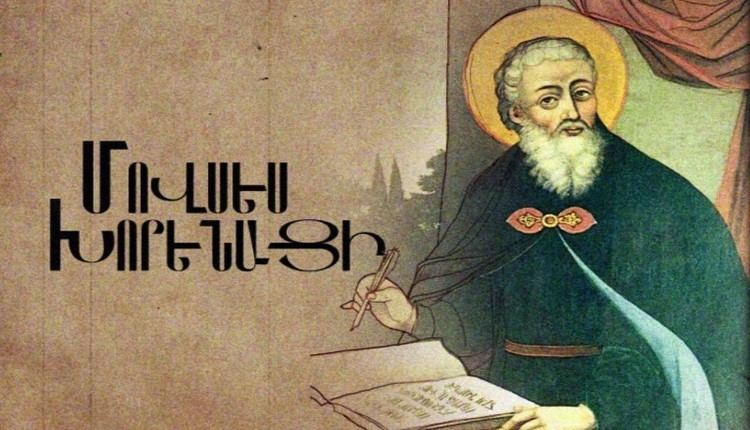 | ||
Similar Mesrop Mashtots, Hayk, Gregory of Narek, Anania Shirakatsi, Gregory the Illuminator | ||
Movses khorenatsi
Movses Khorenatsi (ca. 410–490s AD; Armenian: Մովսես Խորենացի, [mɔfˈsɛs χɔɾɛnɑˈtsʰi], also written as Movsēs Xorenac‘i and Moses of Khoren, Moses of Choren, and Moses Chorenensis in Latin sources) was a prominent Armenian historian from the period of Late Antiquity and the author of the History of Armenia.
Contents
- Movses khorenatsi
- Rev george terian movses khorenatsi lecture part 1
- Early life and education
- Return to Armenia
- History of the Armenians
- Literary influence
- Hypercritical phase
- Modern studies
- Works
- References

Khorenatsi is credited with the earliest known historiographical work on the history of Armenia written in Armenian, but was also a poet, or hymn writer, and a grammarian. The History of Armenia was written at the behest of Prince Sahak of the Bagratuni dynasty and has had an enormous impact on Armenian historiography. It was used and quoted extensively by later medieval Armenian authors. Although other Armenians such as Agathangelos had previously written histories on Armenia, Movses' work holds particular significance because it contains unique material on the old oral traditions in Armenia before its conversion to Christianity and, more importantly, traces Armenian history from Movses' day back to its origins.
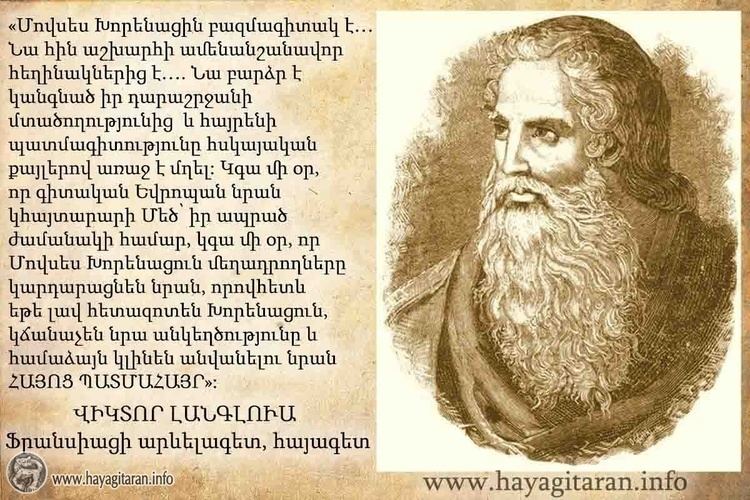
Khorenatsi is considered to be the "father of Armenian history" (patmahayr), and is sometimes referred to as the "Armenian Herodotus." Khorenatsi's work became the first attempt of a universal history of Armenia.

Movses identified himself as a young disciple of Mesrop Mashtots, inventor of the Armenian alphabet, and is recognized by the Armenian Apostolic Church as one of the Holy Translators.
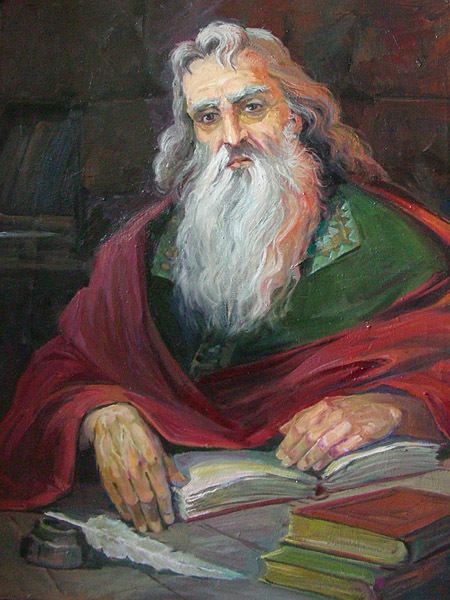
Rev george terian movses khorenatsi lecture part 1
Early life and education
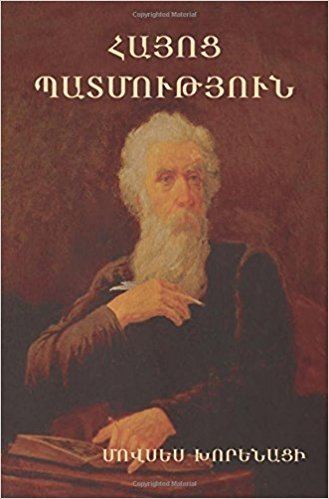
Movses' biographical details are given at the very end of the History of the Armenians but additional information provided by later medieval Armenian historians have allowed modern scholars to piece together additional information on him. Movses was believed to have been born in the village of Khorni (also spelled as Khoron and Khoronk) in the Armenian province of Taron or Turuberan sometime in 410. However, some scholars contend that if he was born here, he would have then been known as Movses of Khorneh or Khoron. They instead move the location of his birth from Taron to the Armenian province of Syunik, in the village of Khorena in the region of Harband.
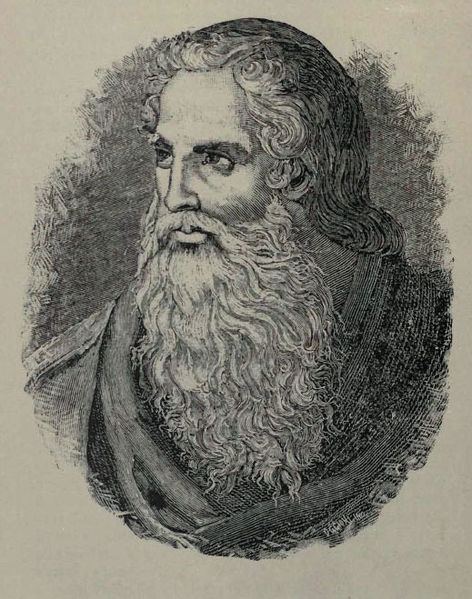
He received his education in Syunik' and was later sent to be taught under the auspices of Mesrop Mashtots, the creator of the Armenian alphabet, and Catholicos Sahak Partev. In having considerable difficulty translating the Bible from Greek to Armenian, Mesrop and Sahak felt the need to send Movses and several of their other students to Alexandria, Egypt, at that time the center of education and learning, so that they themselves learn the Greek and Syriac languages, as well as grammar, oratory, theology and philosophy.
Return to Armenia
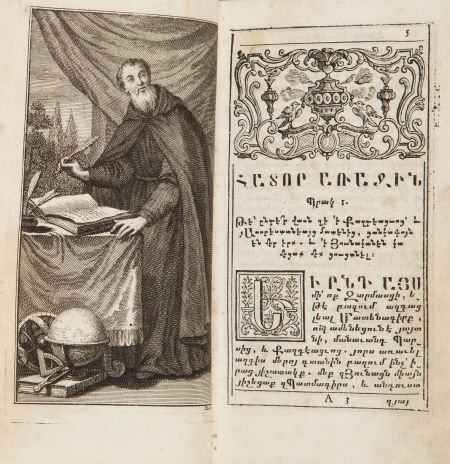
The students left Armenia sometime between 432 and 435. First they went to Edessa where they studied at the local libraries. Then they moved towards Jerusalem and Alexandria. After studying in Alexandria for five to six years, Movses and his classmates returned to Armenia, only to find that Mesrop and Sahak had died. Movses expressed his grief in a lament at the end of History of the Armenians:
While they [Mesrop and Sahak] awaited our return to celebrate their student’s accomplishments [i.e., Movses’], we hastened from Byzantium, expecting that we would be dancing and singing at a wedding...and instead, I found myself grieving at the foot of our teachers' graves...I did not even arrive in time to see their eyes close nor hear them speak their final words.
To further complicate their problems, the atmosphere in Armenia that Movses and the other students had returned to was one that was extremely hostile and they were viewed at with contempt by the native population. While later Armenian historians blamed this on an ignorant populace, Persian ideology and policy also lay at fault, since its rulers "could not tolerate highly educated young scholars fresh from Greek centers of learning." Given this atmosphere and persecution by the Persians, Movses went into hiding in a village near Vagharshapat and lived in relative seclusion for several decades.
Gyut, Catholicos of All Armenians (461-471), one day met Movses while traveling through the area and, unaware of his true identity, invited him to supper with several of his students. Movses was initially silent, but after Gyut's students encouraged him to speak, Movses made a marvelous speech at the dinner table. One of the Catholicos' students was able to identify Movses as a person Gyut had been searching for; it was soon understood that Gyut was one of Movses' former classmates and friends. Gyut embraced Movses and, being either a Chalcedonian Christian, or, at least, tolerant of them (since Movses was also Chalcedonian), brought his friend back from seclusion and appointed him to be a bishop in Bagrevan.
History of the Armenians
Serving as a bishop, Movses was approached by Prince Sahak Bagratuni (died in 482 during Charmana battle against Persian army), who, having heard of Movses' reputation, asked him to write a history of the Armenians, especially the biographies of Armenian kings and the origins of the Armenian nakharar families. Movses agreed to do so and he finished his book sometime in 482. However, Artashes Matevosyan, an expert on medieval Armenian manuscripts, basing his conclusions on new details revealed in his research on the Chronicle by the sixth century Armenian historian Atanas Taronatsi, placed Movses' completion of History to the year 474.
One of his primary reasons for taking up Sahak Bagratuni's request is given in the first part of Patmutyun Hayots, or History of the Armenians: "For even though we are small and very limited in numbers and have been conquered many times by foreign kingdoms, yet too, many acts of bravery have been performed in our land, worthy of being written and remembered, but of which no one has bothered to write down." His work is a first historical record that covered the whole history of Armenia from a very ancient period until the death of the historian. His History served as a textbook to study the history of Armenia until the eighteenth century. Movses' history also gives a rich description of the oral traditions that were popular among the Armenians of the time, such as the romance story of Artashes and Satenik and the birth of the god Vahagn. Movses lived for several more years, and he died sometime in the late 490s.
Literary influence
Three possible early references to Movses in other sources are usually identified. The first one is in Ghazar Parpetsi’s History of the Armenians (about 500 A.D.), where the author details the persecution of several notable Armenian individuals, including the “blessed Movses the philosopher,” identified by some scholars as Movses Khorenatsi. But there is no indication in Parpetsi that this Movses had "composed any historical works." The second one is the Book of Letters (sixth century), which contains a short theological treatise by "Movses Khorenatsi." However, this treatise, not being an historical work, cannot be convincingly attributed to the historian Movses. The third possible early reference is in a tenth-eleventh centuries manuscript containing a list of dates attributed to Athanasius (Atanas) of Taron (sixth century): under the year 474, the list has "Moses of Chorene, philosopher and writer." This mention is, however, considered as too uncertain.
A historian by the name of Moses was unknown to Armenian literature before the tenth century. The references to Moses and the use of information from his book can be found in the works by Movses Kaghankatvatsi, Tovma Artsruni, Hovhannes Draskhanakerttsi and later medieval Armenian authors. According to Tovma Artsruni, Khorenatsi's History had a fourth section which was finished between 470-490. However, there has been no verification of Artsruni's claim.
Hypercritical phase
Beginning in the nineteenth century, as a part of a general trend in those years to reexamine critically the validity of classical sources, Movses' History was cast into doubt after the discovery of historical inconsistencies and anachronisms. The conclusions reached by Alfred von Gutschmid ushered in the "hypercritical phase" of the study of Movses' work. Many European and Armenian scholars writing at the turn of the twentieth century reduced its importance as a historical source and dated the History to sometime in the seventh to ninth centuries. Stepan Malkhasyants, an Armenian philologist and expert of Classical Armenian literature, likened this early critical period from the late nineteenth to early twentieth centuries to a "competition," whereby one scholar attempted to outperform the other in their criticism of Movses.
Modern studies
In the early decades of the twentieth century, scholars such as Frederick Cornwallis Conybeare, Manuk Abeghian, and Stepan Malkhasyants rejected the conclusions of the scholars of the hypercritical school. Ethnographic and archaeological research during this time confirmed information which was found only in Movses' work and supported their view to move back the dating to the fifth century. Despite these studies, these critical points were revived in the second half of the twentieth century and many Western scholars continue to maintain the arguments raised by earlier scholars.
Robert W. Thomson, the former holder of the chair in Armenian Studies at Harvard University and the translator of several classical Armenian works, claimed that Movses' account contained various anachronisms. His approach in evaluating Movses's work was criticized when the English translation of History of the Armenians appeared in 1978. The points he raised have since been challenged. Vrej Nersessian, the Curator of the Christian Middle East Section at the British Library, took issue with many of Thomson’s points, including his later dating of the writing and his contention that Movses was merely writing an apologist work for the Bagratunis:
If so, how does one explain then Moses’s complete preoccupation with the events preceding A.D. 440 and his silence regarding the events leading up the Arab incursions and occupation of Armenia between 640-642? Moreover, if the definite purpose of the History was for “boosting the reputation of the Bagratuni family” then these events should have been central theme of his history; the skilful handling of which brought the Bagratid pre-eminence….The ecclesiastical interests do not point to the eighth century. There is no echo of the Chalcedonian controversy which engaged the Armenians from 451 to 641 when the ecclesiastical unity formulated by the council of Theodosiopolis was renounced.
Gagik Sargsyan, an Armenian scholar of the Classics and a leading biographer of Movses, also admonished Thomson for anachronistic hypercriticism and for stubbornly rehashing and "even exaggerating the statements once put forward" by the late nineteenth and early twentieth-century scholars, and in particular, by Grigor Khalatyants (1858–1912). Sargsyan noted that Thomson, in condemning Movses' failure to mention his sources, ignored the fact that "an antique or medieval author may have had his own rules of mentioning the sources distinct from the rules of modern scientific ethics." Thomson's allegation of Movses' plagiarism and supposed distortion of sources was also countered by scholars who contended that Thomson was "treating a medieval author with the standards" of twentieth century historiography and pointed out that numerous classical historians, Greek and Roman alike, engaged in the same practice. Aram Topchyan, a Research Fellow at the Hebrew University of Jerusalem of Armenian Studies, concurred with this observation, and noted that it was odd that Thomson would fault Movses for failing to mention his sources because this was an accepted practice among all classical historians.
Khorenatsi's work is recognized as an important source for the research of Urartian and early Armenian history.
Works
The following works are also attributed to Movses:
